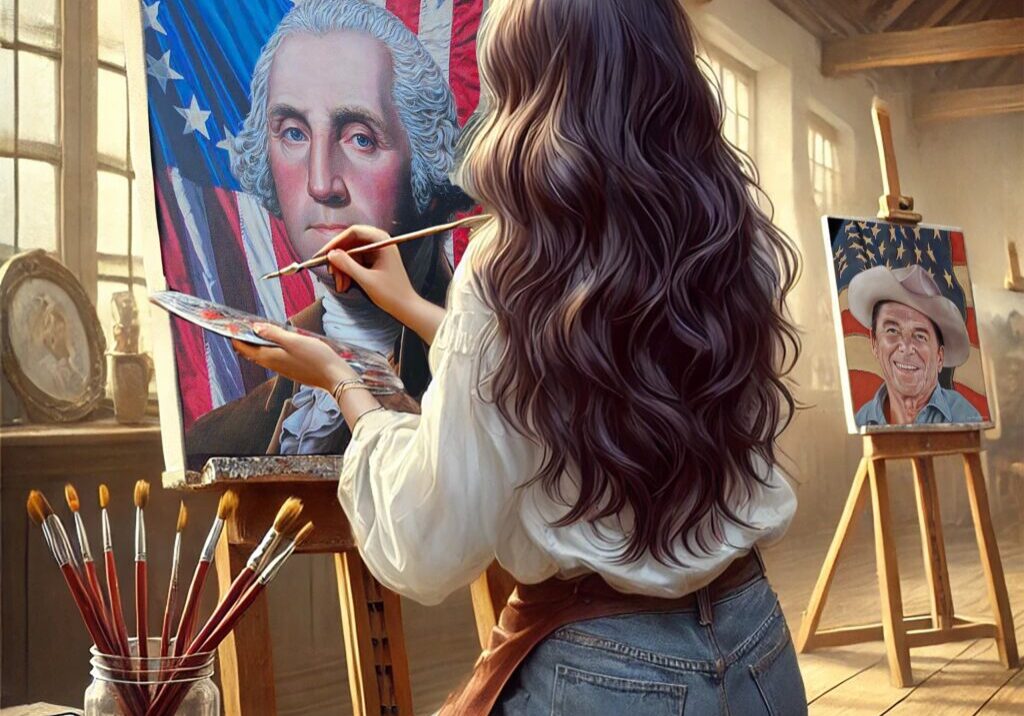
Rendering Revolution: The Artistry of Rosemary Vasquez Tuthill in the 250 Mural
Painting a revolution is more than a challenge – it’s a kind of responsibility. The 250th Anniversary Mural isn’t just a historical timeline. It’s a layered story, made of human choices, emotional stakes, and symbolic echoes. When I began working on the mural, I knew I wasn’t just illustrating moments. I was interpreting how a country found its voice.
My job was to render that story in color, light, and line – in ways that both honor the facts and evoke the spirit behind them. Every decision I make as an artist begins with a question: what did this moment mean to the people who lived it? Not what it means to us now in hindsight, but what it felt like as it unfolded. That’s what guides my choices about composition, expression, and even texture. I try to paint the Revolution not as an event frozen in the past, but as something urgent and breathing – something still unfolding in the spaces between brushstrokes.
I work section by section, but never in isolation. The mural is built to flow – Unity gives rise to Freedom, and Freedom reaches toward Progress. That visual and emotional momentum has to carry through the entire piece, so I’m constantly thinking about the transitions. Sometimes the shift is in light – moving from warm firelit interiors to cooler open-air meetings. Sometimes it’s in posture – hands that once clenched in protest begin to open in collaboration. These transitions matter. They are the movement of story made visible. One of the tools I return to often is balance. Balance between accuracy and atmosphere. Between scale and intimacy. Between structure and spontaneity.
I study the architecture of the period, the clothing, the printed material – but I never let historical detail smother the emotional weight. A perfectly rendered musket means little if the person holding it feels stiff or lifeless. So, I push toward expression. I soften the faces. I follow the lines of tension in the body. I wait until a figure feels like it’s thinking, not just standing. Texture is also a major part of how I convey meaning. I layer paint differently depending on the object’s symbolic weight.
Revolutionary handbills are rendered with more broken edges and visible underpainting – they feel more fragile, more at risk. A marble column might be smoother, more grounded, to suggest permanence. Sometimes I paint in translucencies, letting earlier gestures ghost through the surface. That’s a quiet way of saying: there’s more here than we can see. The mural also contains what I call soft signals – visual elements that hint at broader ideas without being overt. A cracked bell in the distance. A figure glancing away from the crowd. A discarded piece of red cloth underfoot. These are the narrative embers – small moments that carry symbolic heat. They reward the viewer who lingers. And in a mural of this scale, I want people to linger. What I love most about this process is how each section teaches me something new.
When I painted the Unity section, I focused on convergence – on how dissimilar lives and philosophies began to braid together. In the Freedom section, I leaned into contrast and rupture – the tension of a people tearing away from an empire. And now, as I work into Progress, I find myself painting aspiration. Not certainty, but forward motion.
That shift changes the way the brush moves. It lightens the palette. It opens the compositions. I paint knowing that viewers will come with their own eyes, their own histories. So, I try to leave space. Not literal blank space, but interpretive space. Room to connect. Room to reflect. Room to imagine where their own story fits inside this larger arc. To render a revolution is to translate not just action, but intention. And that’s what art can do. It can preserve what people hoped, feared, believed – and pass that forward, in form and in feeling. This mural isn’t just mine. It belongs to the story. My hand simply helps it speak.

